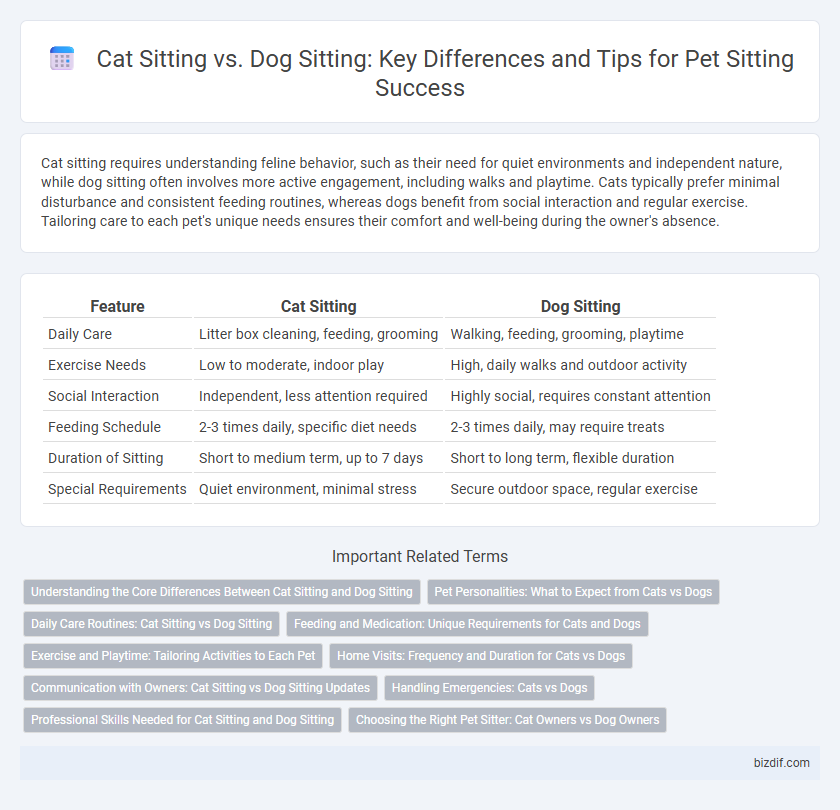Cat sitting requires understanding feline behavior, such as their need for quiet environments and independent nature, while dog sitting often involves more active engagement, including walks and playtime. Cats typically prefer minimal disturbance and consistent feeding routines, whereas dogs benefit from social interaction and regular exercise. Tailoring care to each pet's unique needs ensures their comfort and well-being during the owner's absence.
Table of Comparison
| Feature | Cat Sitting | Dog Sitting |
|---|---|---|
| Daily Care | Litter box cleaning, feeding, grooming | Walking, feeding, grooming, playtime |
| Exercise Needs | Low to moderate, indoor play | High, daily walks and outdoor activity |
| Social Interaction | Independent, less attention required | Highly social, requires constant attention |
| Feeding Schedule | 2-3 times daily, specific diet needs | 2-3 times daily, may require treats |
| Duration of Sitting | Short to medium term, up to 7 days | Short to long term, flexible duration |
| Special Requirements | Quiet environment, minimal stress | Secure outdoor space, regular exercise |
Understanding the Core Differences Between Cat Sitting and Dog Sitting
Cat sitting requires a deep understanding of feline behavior, emphasizing independence, routine, and a quieter environment, while dog sitting focuses on active engagement, regular walks, and social interaction. Cats often need less frequent feeding and more individualized attention to their unique preferences, whereas dogs benefit from consistent exercise and companionship to prevent anxiety. Recognizing these core differences ensures tailored care that caters to the specific emotional and physical needs of each pet, enhancing their well-being during the owner's absence.
Pet Personalities: What to Expect from Cats vs Dogs
Cat sitting requires understanding their independent and often aloof nature, as cats tend to prefer solitary activities and may take time to warm up to new people. Dog sitting involves managing more social and energetic personalities, with dogs often seeking constant interaction, playtime, and routine. Recognizing these distinct pet personalities ensures a comfortable and stress-free experience for both cats and dogs during their owner's absence.
Daily Care Routines: Cat Sitting vs Dog Sitting
Daily care routines for cat sitting emphasize litter box maintenance, grooming, and providing quiet, comfortable spaces, while dog sitting prioritizes regular walks, playtime, and social interaction. Cats typically require less frequent feeding and benefit from periodic attention, whereas dogs need consistent exercise and structured routines to maintain their physical and mental health. Understanding these differences ensures tailored care that meets the unique needs of each pet species.
Feeding and Medication: Unique Requirements for Cats and Dogs
Cat sitting often requires precise portion control and timing for feeding due to cats' sensitive stomachs and finicky eating habits, while dog sitting typically involves scheduled meals with larger quantities. Medication administration for cats can be more challenging, as they often resist pills or syrups, necessitating specialized techniques like hiding medicine in treats or using pill pockets. Dogs generally tolerate medications better but may require careful dosage adjustments based on breed size and health conditions.
Exercise and Playtime: Tailoring Activities to Each Pet
Cat sitting emphasizes interactive play with toys like feather wands and laser pointers to stimulate a cat's hunting instincts and mental agility. Dog sitting often involves structured outdoor exercise such as walks, fetch games, and agility training to meet a dog's higher energy levels and social needs. Tailoring activities according to each pet's species-specific behavior ensures their physical health and emotional well-being during pet sitting.
Home Visits: Frequency and Duration for Cats vs Dogs
Cat sitting home visits typically require shorter, more frequent check-ins, around 15-30 minutes daily, to accommodate their independent yet routine-oriented nature. Dog sitting demands longer visits, usually 30-60 minutes, multiple times per day to provide necessary exercise, playtime, and social interaction. The frequency and duration of home visits differ significantly due to cats' lower activity levels and dogs' higher energy and social needs.
Communication with Owners: Cat Sitting vs Dog Sitting Updates
Cat sitting requires subtle, detailed updates emphasizing a cat's behavior, eating habits, and mood, as cats tend to be more independent and less expressive than dogs. Dog sitting allows for more dynamic communication, including information on exercise routines, social interactions, and training progress, which are important for an active and social pet. Clear, frequent, and tailored updates build trust, ensuring owners feel connected and informed about their pets' well-being regardless of species.
Handling Emergencies: Cats vs Dogs
Handling emergencies for cats often requires quick attention to subtle signs such as sudden hiding, refusal to eat, or rapid breathing, which can indicate critical conditions like poisoning or respiratory distress. Dog emergencies are more overt, with symptoms like continuous vomiting, seizures, or severe injuries demanding immediate veterinary care. Effective pet sitters must understand these species-specific emergency cues to provide timely and appropriate interventions.
Professional Skills Needed for Cat Sitting and Dog Sitting
Cat sitting requires expertise in recognizing feline body language, managing litter box hygiene, and providing a calm environment to reduce stress, while dog sitting demands skills in leash handling, understanding canine behavior, and administering regular exercise. Professional cat sitters must be adept at monitoring subtle health signs like changes in eating or grooming, whereas dog sitters often need training in obedience commands and safe play techniques. Both roles benefit from strong communication skills to update pet owners and ensure tailored care according to each animal's specific needs.
Choosing the Right Pet Sitter: Cat Owners vs Dog Owners
Cat owners prioritize pet sitters experienced in independent animal care, emphasizing quiet environments and routine feeding schedules to reduce feline stress. Dog owners often seek sitters skilled in active engagement, including walking, playtime, and socialization to meet a dog's exercise needs. Understanding these distinct preferences ensures cat and dog owners select sitters who provide tailored care for each pet's comfort and well-being.
Cat sitting vs Dog sitting Infographic

 bizdif.com
bizdif.com